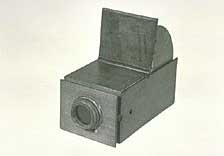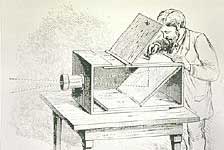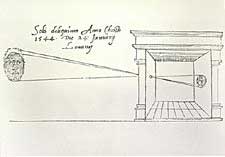Story Title
Dutch mathematician R. Gemma FRISIUS made this illustration of the solar eclipse
that occurred on January 24, 1544, viewed using camera obscura.
It is believed, however, that camera obscura dates to ancient Greece, where
Aristotle (384 B.C. to 322 B.C.) may have formulated its principle.
The oldest written record of the principle is attributed to Leonardo DaVinci (1452 to 1519).
The image created by a pin-hole camera is very dark.
Sometime in the 16th century, it was discovered that an optical lens could enhance an image
by making it brighter. One practical application of this new finding was for painting, for
which optical lenses were used as sketching and tracing tools. (See "Photos 1" and "2")
 "Photo 1." : Camera obscura with an optical glass
(Photo courtesy of the JCII Camera Museum)
"Photo 1." : Camera obscura with an optical glass
(Photo courtesy of the JCII Camera Museum)
The image size of this camera, made in England around 1770 AD, is 6cm Å~ 6cm. (To put this in perspective, visualize a modern 6 Å~ 6 film camera.) It is a reflex-type camera with a built-in mirror, which ensures the image will not appear upside down, though it does appear in reverse.
 "Photo 2." : Camera obscura used for sketching
(Photo courtesy of the JCII Camera Museum)
"Photo 2." : Camera obscura used for sketching
(Photo courtesy of the JCII Camera Museum)
This ("Photo 2.") illustratesthe use and mechanism of a camera obscura similar to the one shown in "Photo 1.".
Upon close inspection, it is clear that the mechanism resembles that of an SLR camera. Because this model uses
optical glass, the focusing point must be adjusted.
Therefore, the design allows the length of both the camera obscura and the lens to be adjusted.
A camera obscura using a lens is able to place bright pictures on a "focusing screen."
In the early history of the camera, the challenge was to take that image and fix it, mechanically or chemically,
to create a "photograph."
This would render sketching and tracing obsolete.

